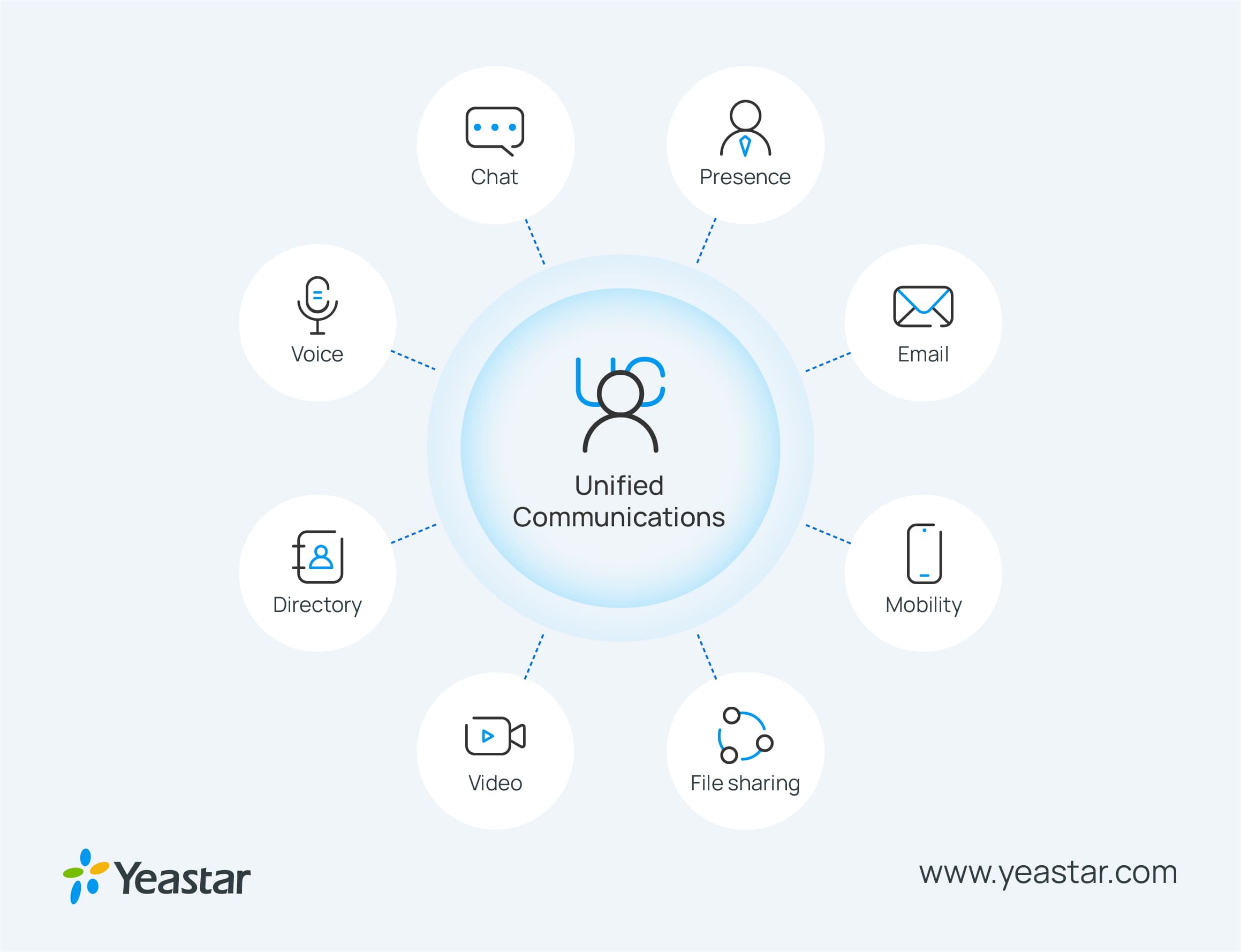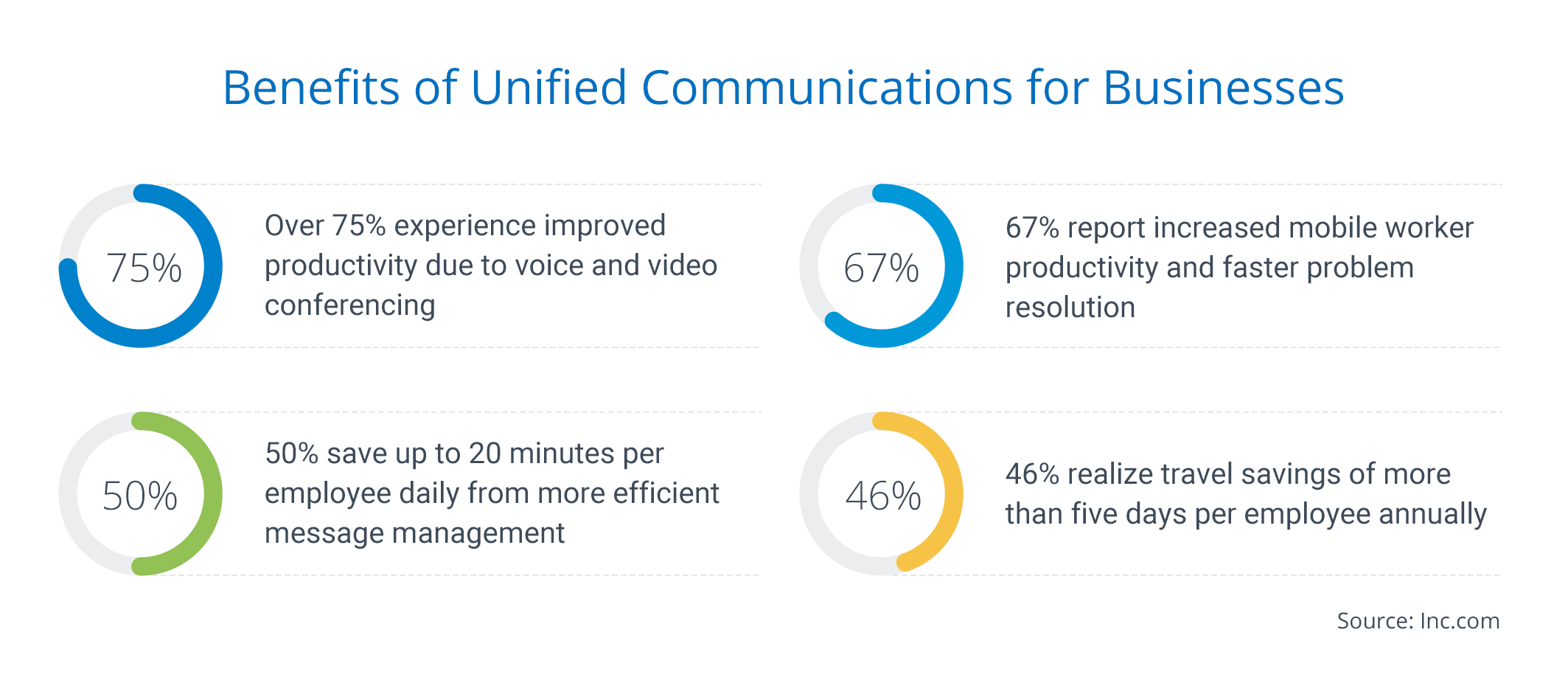
Table of Contents
- What is Unified Communications →
- The Origin of UC →
- Unified Communications & Collaboration to The Rescue →
- The Benefit of UCC →
- Components of UCC →
- Collaboration & Communication Work Together →
- Unified Messaging & Unified Communications →
- What Does a UC Implementation Look Like? →
- Implement Unified Communications in Your Office Today! →
What is Unified Communications
Unified Communications is often referred to as UC or in some instances UCC. The latter is the term that includes the word collaboration. Unified communications is the integration of many different types of communication that happen in real-time. These include text messaging, voice communication, video, even collaboration. Today, businesses are enhancing their traditional PBX systems that are voice-focused with unified communications options. In some cases, they are seeking to replace these entirely. The goal here is to boost productivity, improve collaboration, support mobile workforces, and to better allow for BYOD.
The Origin of Unified Communications
Unified communications isn’t a new concept. It really began in the late 1990s. This was when it first became common for individual workers to have a dedicated, desktop PC. Now, the demand for unified communications has grown significantly as ownership of smartphones and constant internet connectivity has become the new norm.
On a positive note, all of these new devices and the ability to connect from anywhere at any time led to the ability to communicate like never before. Unfortunately, the result was often messy at best. At any given time, someone might be managing contacts in multiple different places, carrying on conversations through several platforms, all while juggling two or more devices.
Unified Communications And Collaboration to The Rescue
What is unified communications? Unified communications (UC) means there is a single place to manage many conversations to include mobile devices, PCs, smartphones, office phones, and tablets. It also includes several different kinds of communication such as instant messaging, phone calls, video calls, and texting. Include collaboration, and that brings in technologies that allow file sharing, digital whiteboards, desktop sharing, video conferencing, etc.
When a company decides to adopt unified communications they can pick between an on-site solution or one that is cloud-based.
Unified Communications And Collaboration to The Rescue
It may be that simplification is the most important benefit of unified communications. That’s because unified communications and collaboration take everything your team uses to connect, collaborate, and share together into a single, streamlined solution. Here is what that gives you:
- Cost Savings: Especially with cloud-based UC that allows companies to implement unified communications with less initial outlay and reduce overall operating costs.
- Boosted Productivity: When team members can connect with one another using the methods and devices that are most comfortable to them, they work more efficiently.
- Better User Experience: One of the less mentioned benefits of unified communications, workers simply do better when the collaboration tools they use are intuitive and more enjoyable to use.
- Improved Customer Service: Unified communications and collaboration gives workers the tools they use to address customer issues effectively, and leads to happier customers.
- Increased Morale: Unified communications solutions make collaboration easier, and give workers freedom of choice when it comes to the devices they use. This autonomy is a welcome benefit.

Unified Communications And Collaboration Components
A unified communications (UC) solution consists of two components. The server-side component of UC will either be cloud-based or will be implemented on-site. If you select on-site, you may work with a vendor who will provide and maintain specific servers for your unified communication needs. In other cases, the unified communications solutions provider will simply offer software that you can run on a Windows or Linux server of your choice.
Unified Communications as a Service (UCaaS) is often used as the preferred term for cloud UC services. There are multiple benefits of selecting this as your UC communications option. Primarily, it allows you to implement unified communications (UC) without investing a lot of capital in equipment and managing ongoing support and maintenance needs. Even better, this is a solution that meshes well with mobile workforces. Users are never inhibited by geography. They are able to connect to the real-time communication services they need as long as they have access to the internet. Further, cloud-based UC works quite well with disaster recovery applications and helps to ensure ongoing business continuity.
Collaboration And Communication Work Together
The best unified communications solution takes both business communications needs and the importance of collaboration into consideration. Consider some additional information on both.

Business Communication
Unified communication is a solution that enables businesses to engage in communication that is more efficient and more effective. This impacts both internal and external communication. Internal business communication is the sharing of information within the organization. External communication is sharing of information with customers, vendors, and other external entities. This sharing can be done via voice communications, email, text message, web conferencing, video conferencing, and instant messaging.
Business Collaboration
Collaboration is generally viewed as part of the internal communication strategy. The idea is to provide employees with collaboration tools that they can use to share information and work together as a team. When these solutions work, they result in increased productivity, improved problem-solving, and customer-friendly solutions. In many instances, collaboration tools are designed to work in real-time.
It may help to see unified business communication as the framework that collaboration is built on. Once a viable business communications solution is in place, collaboration tools may be used on top of that UC solution to make it even more powerful. In addition to offering VoIP, business phone solutions, conference calls, instant messaging, etc. UCC can integrate features like:
- File Sharing
- Desktop Sharing
- Screen Sharing
- Annotation Tools
- Web and Video Conferencing
- Real-Time Chat
- Digital Whiteboards
All of these are communication tools that lead to the following benefits when they are a part of UC solutions:
- Enabling teams to connect with one another regardless of device or geography.
- Building teams that are based on expertise instead of the location.
- Facilitating document management
- Easier project tracking and change management.
- Faster project resolution.
- Real-time project collaboration
- Discovering ways to improve business processes
Unified Messaging And UC
Unified messaging is related to UC, but it is not the same. Unified messaging encompasses various digital messaging means such as email, voicemail, and IM. UC solutions may include a user interface that integrates unified messaging with VoIP, video calls, audio&video conferencing, mobility, and other features to go beyond the traditional phone system.
What Does a UC Implementation Look Like?
UC systems can vary depending on the vendor, and the services that have been selected by the customer. However, most minimally cover the following:
- VoIP (Voice Over Internet Protocol)
- Mobility
- Messaging
- Video
- Chat
- Web Conferencing
In the case of Yeastar Linkus UC Clients, these functions are integrated into a single user interface, so they can be accessed when users need them. Linkus UC Clients are available on the web, mobile phones, and PC. This makes it easy for users to access real-time communication solutions from web browsers or your personal devices no matter where they are. The interface includes:
Business Phone Call Management
Employees may make and receive phone calls from any device using VoIP. They may hold, transfer and record calls. They may also set up call forwarding rules and ring strategies. Finally, it is also easy to check call logs and voicemails in one single interface.
Integrated Video Conferencing
Linkus is more than just a softphone to your business phone system. It incorporates multiple services to be a full-service solution for communications and collaborations. This includes the ability to instantly create and launch a video conference with features such as screen sharing and group chat.
Other Helpful Features For Businesses
Here are some of the other productivity tools for your enterprise:
- Instant Messaging: Use IM for one-on-one, group chats, and integrated file sharing.
- Native Contacts Management: Manage corporate-wide and your personal contacts, and sync them across devices.
- Remote Desk Phone Control: Perform click-to-dial, call transfer/hold/retrieve on Linkus Desktop Client’s visual user interface while using the desk phone as their audio path.
- Presence: See which users are available, busy, out of the office, etc. with colorized status indicators and customized descriptions.
- CRM Integration: Integrate with Zoho, Dynamics 365, Google Contacts, and other CRM platforms.
- Click to Call: Available with Yeastar Linkus for Google Chrome extension to turn every phone number into a clickable link and enable easy dialpad, call pop-ups, advanced call control directly with browser tabs.
Implement Unified Communications in Your Office Today!
Regardless of your company’s strategy, using a cloud-based phone system service is a straightforward way to save money on something that is absolutely paramount to all businesses: telecommunications. Unified communications systems used to be complicated and expensive, but with the rise of the internet and VoIP PBX services, not only did modernizing the office phone solutions get more convenient, but also turned into a way to save a lot of money in the long run! Contact Yeastar to learn more about the best way of implementing unified communications in your office!

